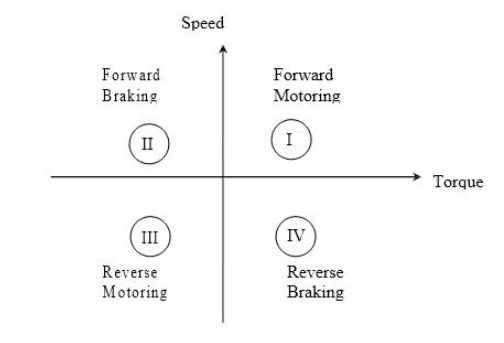Chapter: Solid State Drives : Drive Characteristics
Multi quadrant Operation
Multi quadrant Operation:
For
consideration of multi quadrant operation of drives, it is useful to establish
suitable conventions about the signs of torque and speed.
A motor
operates in two modes – Motoring and braking. In motoring, it converts
electrical energy into mechanical energy, which supports its motion .In braking
it works as a generator converting mechanical energy into electrical energy and
thus opposes the motion.
Now
consider equilibrium point B which is obtained when the same motor drives
another load as shown in the figure. A decrease in speed causes the load torque
to become greater than the motor torque, electric drive decelerates and
operating point moves away from point B.
Similarly
when working at point B and increase in speed will make motor torque greater
than the load torque, which will move the operating point away from point B
Similarly
operation in quadrant III and IV can be identified as reverse motoring and
reverse braking since speed in these quadrants is negative.
For
better understanding of the above notations, let us consider operation of hoist
in four quadrants as shown in the figure. Direction of motor and load torques
and direction of speed are marked by arrows
The
figure at the right represents a DC motor attached to an inertial load. Motor
can provide motoring and braking operations for both forward and reverse
directions.
Figure
shows the torque and speed co-ordinates for both forward and reverse motions.
Power developed by a motor is given by the product of speed and torque. For
motoring operations Power developed is positive and for braking operations
power developed is negative.

For
better understanding of the above notations, let us consider operation of hoist
in four quadrants as shown in the figure. Direction of motor and load torques
and direction of speed are marked by arrows.


A hoist
consists of a rope wound on a drum coupled to the motor shaft one end of the
rope is tied to a cage which is used to transport man or material from one
level to another level . Other end of the rope has a counter weight. Weight of
the counter weight is chosen to be higher than the weight of empty cage but
lower than of a fully loaded cage.
Forward
direction of motor speed will be one which gives upward motion of the cage.
Load torque line in quadrants I and IV represents speed-torque characteristics
of the loaded hoist. This torque is the difference of torques due to loaded
hoist and counter weight. The load torque in quadrants II and III is the speed
torque characteristics for an empty hoist.
This
torque is the difference of torques due to counter weight and the empty hoist.
Its sigh is negative because the counter weight is always higher than that of
an empty cage. The quadrant I operation of a hoist requires movement of cage
upward, which corresponds to the positive motor speed which is in counter
clockwise direction here. This motion will be obtained if the motor products
positive torque in CCW direction equal to the magnitude of load torque TL1.
Since
developed power is positive, this is forward motoring operation. Quadrant IV is
obtained when a loaded cage is lowered. Since the weight of the loaded cage is
higher than that of the counter weight
.It is
able to overcome due to gravity itself.
In order
to limit the cage within a safe value, motor must produce a positive torque T
equal to TL2 in anticlockwise direction. As both power and speed are
negative, drive is operating in reverse braking operation. Operation in
quadrant II is obtained when an empty cage is moved up. Since a counter weigh
is heavier than an empty cage, its able to pull it up.
In order
to limit the speed within a safe value, motor must produce a braking torque
equal to TL2 in clockwise direction. Since speed is positive and
developed power is negative, it’s forward braking operation.
Operation
in quadrant III is obtained when an empty cage is lowered. Since an empty cage
has a lesser weight than a counter weight, the motor should produce a torque in
CW direction. Since speed is negative and developed power is positive, this is
reverse motoring operation. During transient condition, electrical motor can be
assumed to be in electrical equilibrium implying that steady state speed torque
curves are also applicable to the transient state operation.
Related Topics